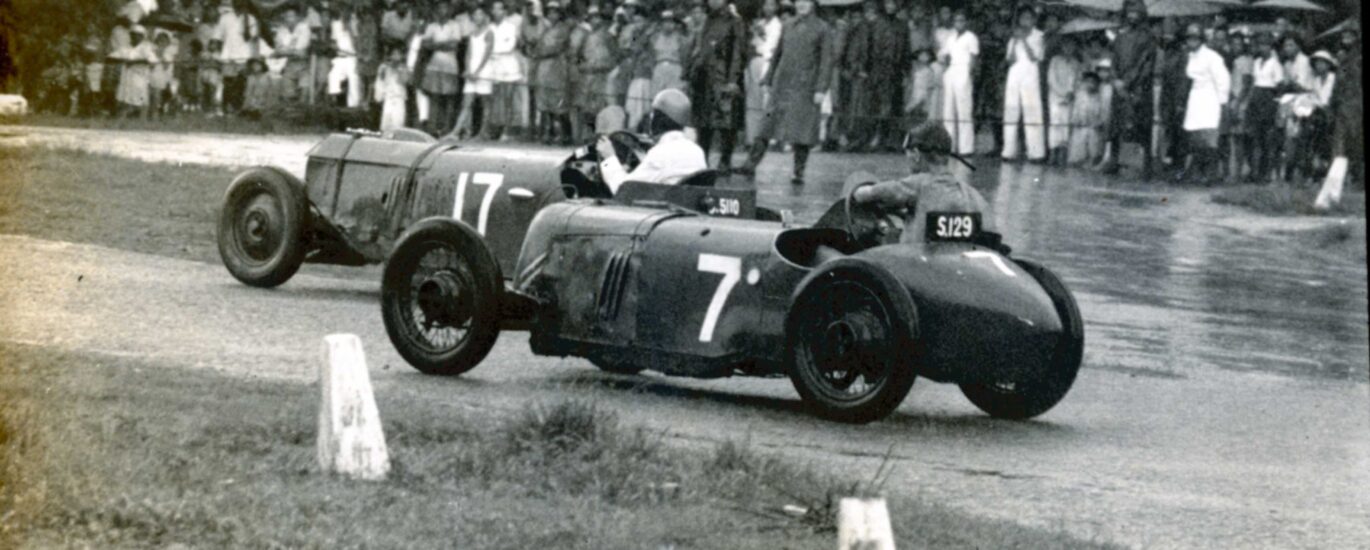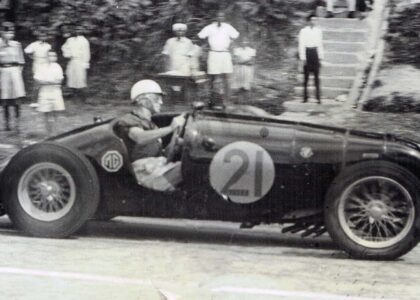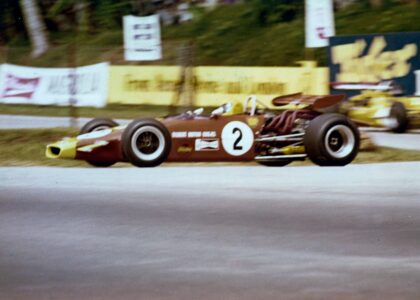Updated with additional images on 13 February 2024
The first Grand Prix in Asia – 1940
In British Malaya, an audacious group of men got together to try and organise a Grand Prix race, the first in Malaya, and, indeed, in Asia. Port Swettenham Aerodrome on Selangor’s western seaboard was the chosen venue for the Grand Prix, coincidentally set for 3 September 1939, the very day Britain and France declared war on Nazi Germany.
Port Swettenham Aerodrome was constructed in 1930 and was situated just two miles from the busy harbour of Port Swettenham (now Port Klang). The aerodrome was left in a state of disrepair until it was reopened to traffic on 17 September 1937 with two metalled runways. However, events contrived to force the cancellation of the proposed Grand Prix: Declaration of war in Europe and the Second Sino-Japanese War. Closer to home, a cholera epidemic meant that any thought of racing had to be abandoned.
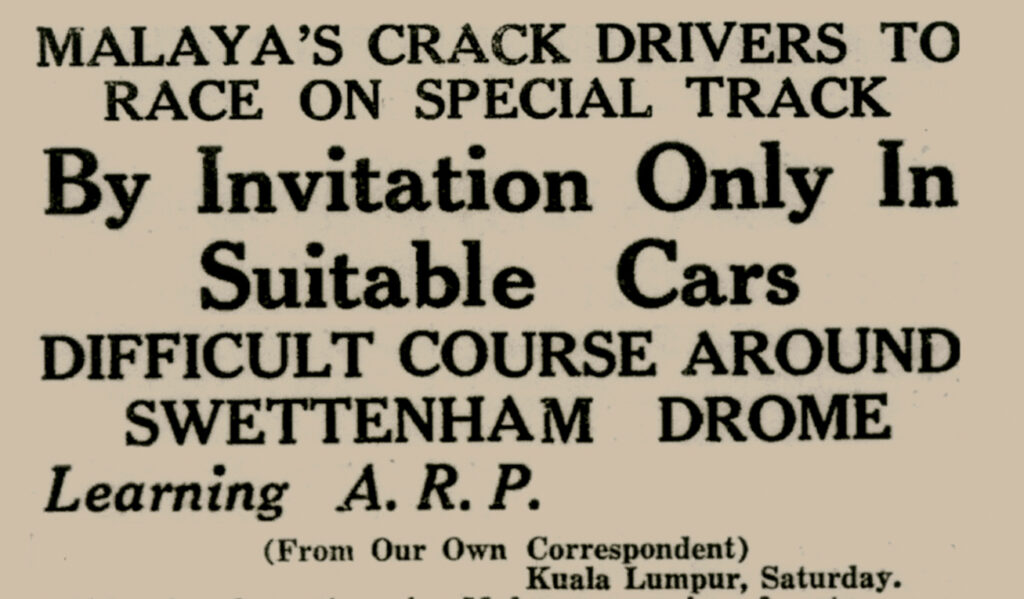
WAR EFFORT
A WAR EFFORT: Against the odds, many of the same people behind the proposal of the Malayan Grand Prix came together to orchestrate another motor race a year later, well after motor sports had ground to a halt in Europe. All three English language newspapers (The Straits Times, The Singapore Free Press and The Malaya Tribune) covered the official announcement in their 10 October 1940 editions.
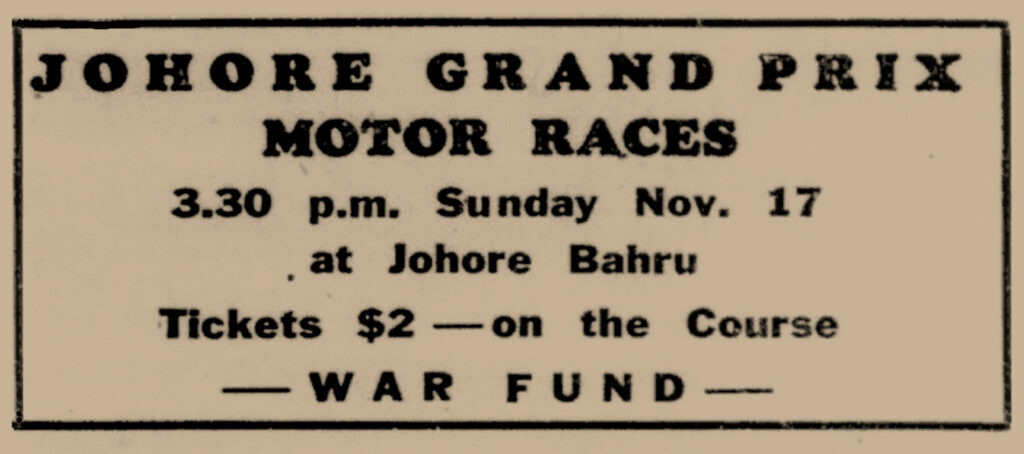
Competitors may have had a clue that such an event was in the making but it certainly caught the public by surprise. The organisers called it the War Effort Grand Prix – to raise funds for Britain’s battle against Nazi Germany. With the patronage of the Tunku Mahkota (Prince Regent) of the State of Johore, and the support of the Singapore and Johore branch of the Automobile Association of Malaya (AAM), Johore Bahru provided a new location for the War Effort Grand Prix. Tickets were priced at $2, available at Little’s flagship store in Singapore’s business district and the general provision store Johore Cold Storage on Jalan Ibrahim in, the main street in Johore town. Paying spectators could watch the races from the grandstands as well as tour the paddock.
STREET FIGHTS
STREET FIGHTS: A section of the then newly constructed Johore bypass road and adjacent roads fitted the bill and thus a 1.7-mile street course was conceived, located near the main railway line and Jalan Tebrau, the major trunk road leading to Kota Tinggi and Johore Lama, the seat of the old Johore Sultanate. The causeway linking Johore Bahru and Singapore lay a short distance south.
The race circuit included the water tower on the hill overlooking Johore town, next to the water source of Sungei Ayer Molek, and ran in an anti-clockwise direction. Practice was set to commence from 2.30pm on Sunday, 10 November 1940; official qualifying on Saturday, 16 November, with four events; and the main races on Sunday, 17 November, also with four events. Timing could not have been worse. The most devastating of German bombing over Coventry (The Coventry Blitz) occurred on the evening of 14 November 1940 and continued into the morning of 15 November which would have put a dampener on the mood of entrants (some of whom were military men) and spectators. War drums aside, things simply didn’t go to plan. Instead, it took three weekends to see the event to completion, thanks to calamitous weather.
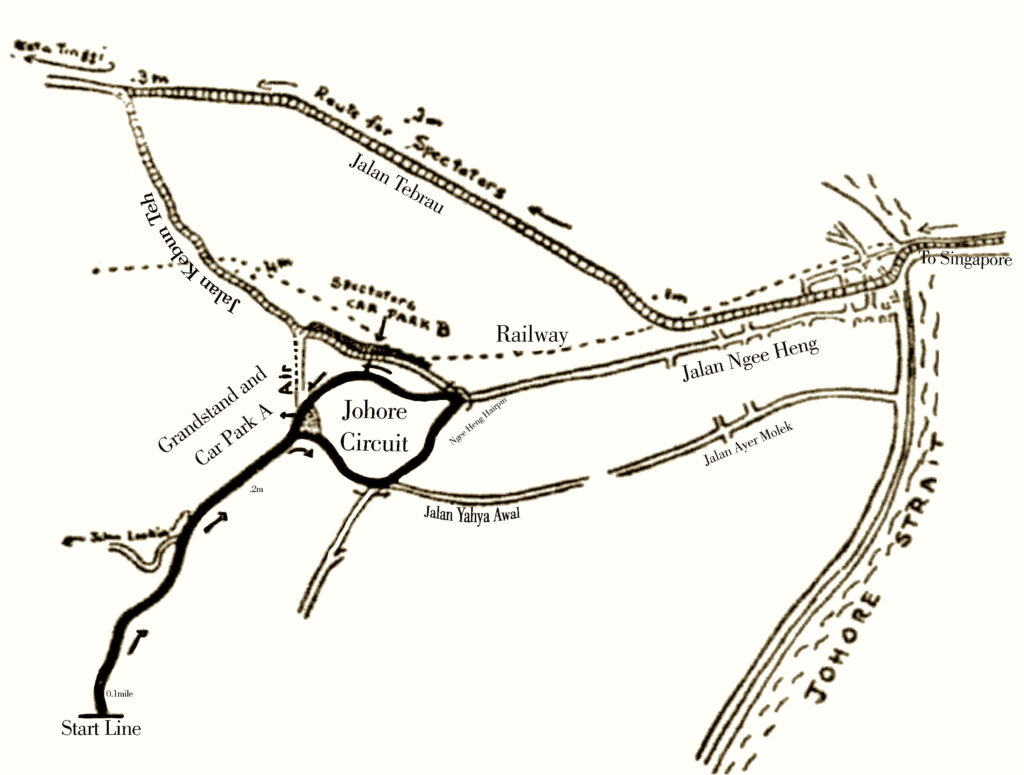
On Sunday, 10 November, competitors took their cars out onto the circuit between 2.30pm and 6.30pm. It was a typical Malayan afternoon, a torrential downpour clearing the air before the emerging sun bathed and baked the land. The session had been delayed for an hour before competitors eventually had a good run in the dry. There was much excitement and exchange of opinions about the brand-new track as soon as the competitors returned to the paddock from practice. There were also few absent faces. The Ferguson brothers, Perak-based planters Bill and Fred, were busy with duties at the Royal Air Force Government Flying Training School at Kallang Airport, ‘Fred’ Freddy Milne Ferguson having commenced his cadet training in October 1940 and ‘Bill’ James George Milne Ferguson, in the second batch of cadets, started his in March 1941. Planter Charles Derek Bovet White, later to join the Fergusons as very active racers in post-war Malaya, was also a flight training school cadet in October 1940.
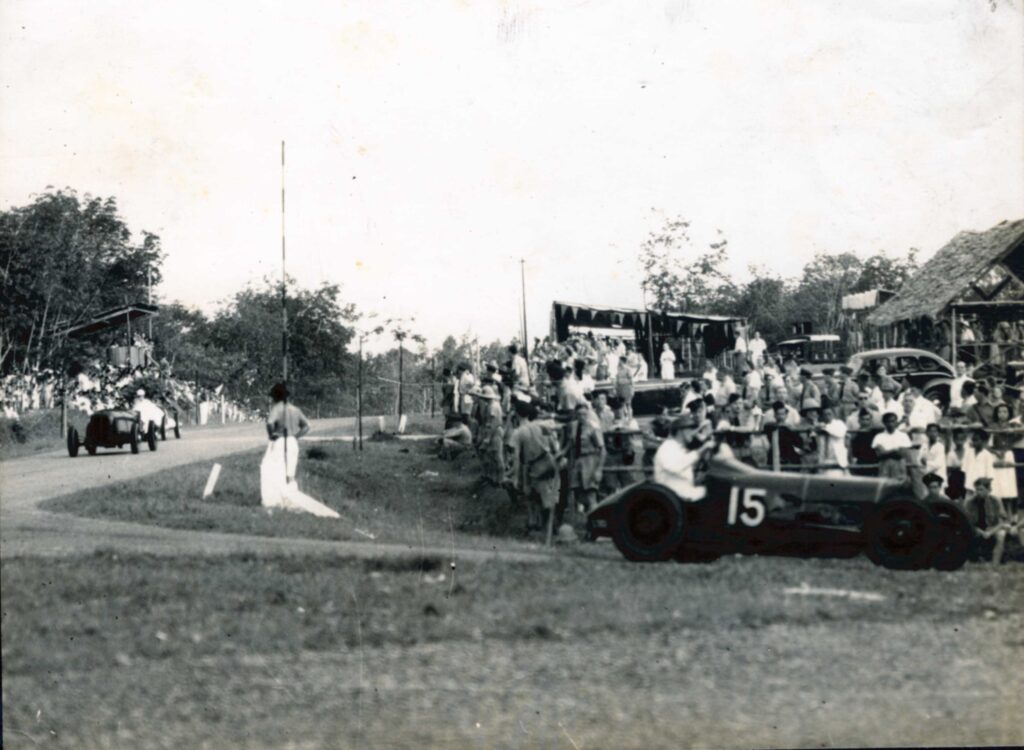
On the rare occasion that the sun shone, spectators came out in full force. Many, including the dhoti-clad fellow standing perilously close to the apex of the corner, found the going entirely alien. The photo show Anthony Phillips leading Jimmy Milne and Conrad Oldham through Water Tower Corner.
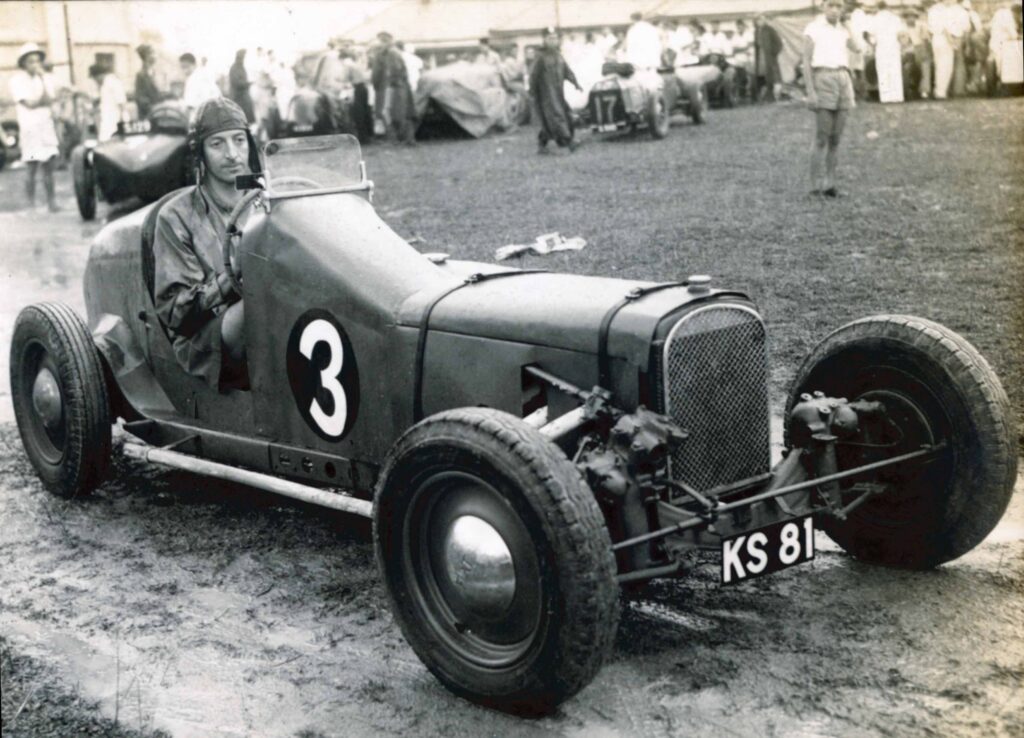
Charles Vernon Crowther-Smith and his very fast Fiat Special. Behind can be seen Arthur James Loughborough – Alpha & Omega Fiat Special, Reddish’s Austin Seven and Chevremban, Lim Peng Han’s LA, and Anthony Dockray Phillips’ LA.
AROUND THE HOUSES
AROUND THE HOUSES: “This course is wicked,” bemoaned Conrad Oldham, Magistrate and Chairman of the Singapore branch of the Automobile Association of Malaya, after he had completed two fast practice laps in his very long L.A. Ghost, a car built specially for him in June 1939 by Singapore’s crack Specials builder Lim Peng Han [see THE GHOST OF MALCOLM ROAD]. Judge Oldham was undoubtedly referring to the hairy hairpin bend at Jalan Ngee Heng where the ungainly Ghost would have lost considerable time. Lim was also responsible for another Special, Captain Peter K. Braid’s Fiat straight-six 1493cc overhead valve race car aptly called the Braid Special, a replacement for his high-strung L.A.-MG Monoposto, an equally highly strung machine based around an MG TA. Braid was stationed in Singapore as part of the Hong Kong & Singapore Royal Artillery, Singapore Garrison, and he and his wife Margaret were active members of the AAM. It was through Lim’s ingenuity and industry that at least six of the 16 entries had passed through or been created at his very active Veerasamy Road garage.
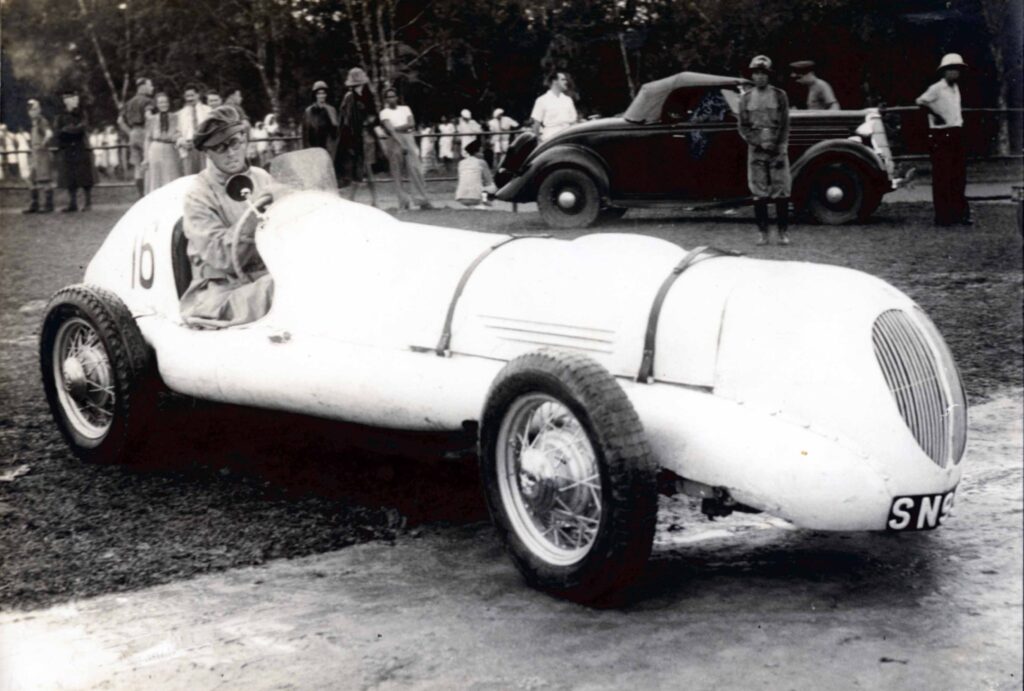
A rare shot of Conrad Oldham and his “wretched” Ghost at the 1940 Johore Grand Prix.
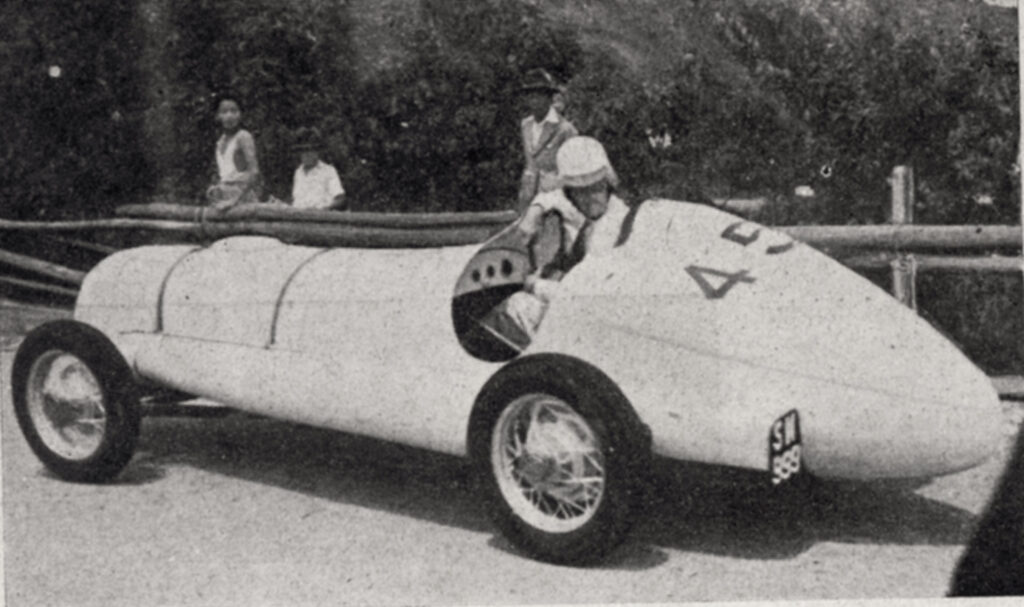
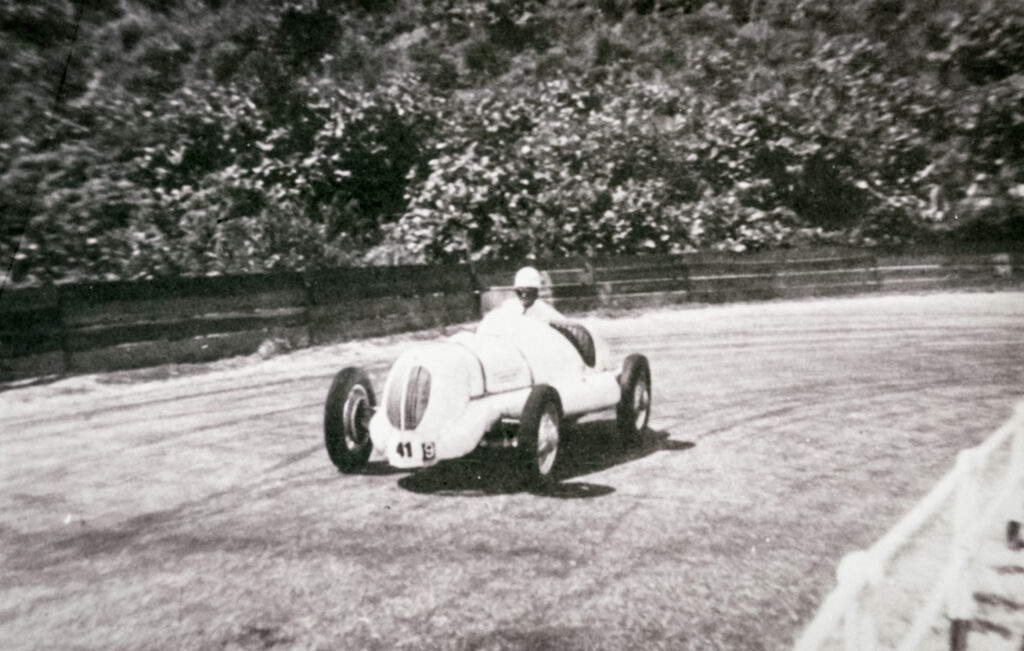
Captain Cyril Oswald ‘Mick’ Jennings, another leading figure in the Malayan motor sports movement, called it a “sporty course”. Jennings had a very rare, supercharged MG K3 Magnette (chassis K3007), the ex-Ron Horton-Major Goldie Gardner car that journalist Denis Jenkinson referred to as “a highly-developed track-racing car” [see THE REAL CAPTAIN MG – PART I]. There is little doubt that the K3, which Jennings acquired from the MG factory in Abingdon around September 1939 while on vacation in Britain, would have been the most sophisticated (and most complex) car on the circuit in a grid comprising a supercharged 747cc Austin Special, a 1-litre four cylinder Fiat Victoria Special from Perak, a pair of straight-six OHV Fiat-engined L.A. Specials, a pair of 2663cc SS Jaguars (one of which was an SS100), four 3622cc Ford V8s, a singular Alvis Speed 20 and a Talbot-Salmson-Amilcar Special called the Bitzer (which the owner advertised for sale at $600 shortly before the Grand Prix!), to name a few [see MONSTERS & MAVERICKS MALAYAN/SINGAPORE POST-WAR SPECIALS].
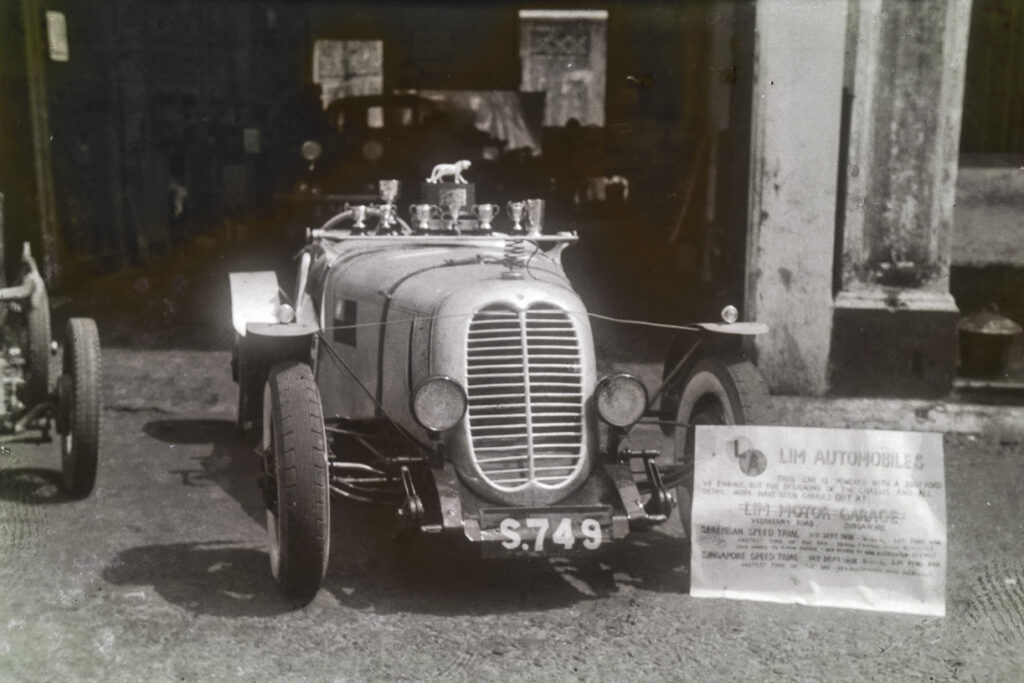
Foreign invitations had also gone out and 56-year-old Siamese barrister Nai Charoon na Bangchang’s late entry Alfa Romeo 6C-1750 from Thailand apparently arrived in Singapore in time for the event. Rumours had been circulating after the weekend’s practice session, but it appears that the 140mph silver Alfa Romeo developed an electrical fire just before shipping out of Bangkok. There was another rumour that Peter Braid’s L.A.-MG Monoposto would mysteriously develop mechanical trouble before race weekend, allowing the officer to participate in the very desirable Alfa Romeo race car. Come 10 November, the Alfa Romeo was nowhere to be seen and Captain Braid had his Special ready for his runs.

L.A. Special No.1 now belonged to Penang-born 30-year-old James “Jimmy” Milne, then a Service Manager at Universal Motors in Singapore. Milne modified the car with a new radiator and a lengthened nose cowling. The chassis also had some work done to it. Milne continued racing well into his 50s, his last race in Singapore was in 1963 when he worked for George Lee Motor’s Ford cars and trucks division in Singapore.
The weekend racing provided a welcomed distraction from worries of the future and anticipation was running high. Practice on Sunday was unusual. Following individual runs, the cars were released in pairs for two-lap “races” with Borneo Motors’ Geoffrey Maund (4.56) against Jennings (4.27); Jimmy Milne (4.55 1/5) against Braid (4.23 3/5); Lim Peng Han (3.59 4/5) against Judge Oldham (4.19 1/5); and Lim Kok Tai (4.24 4/5) against Captain R.D. Bell R.A.M.C. (4.14 3/5). Lim Peng Han set the early pace during the course of these runs, setting with the fastest lap in his Ford V8 L.A. Special, the first car to go under two minutes around the 1.8-mil circuit with a time of 1m 59 4/5s. Lim Kok Tai set second fastest lap at 2.5m 4/5s in his No.5 MG TB. Everyone was taking things easy, this was after all, the first Grand Prix held in the region. 22-year-old Flight-Lt. Anthony Dockray Phillips had a scare when one of the water hoses in his Ford V8 motor burst with nearly disastrous consequences. Phillips narrowly averted catastrophe and emerged with scratches and a slightly damaged L.A. Special that ended up in a drain, thankfully without too much damage.
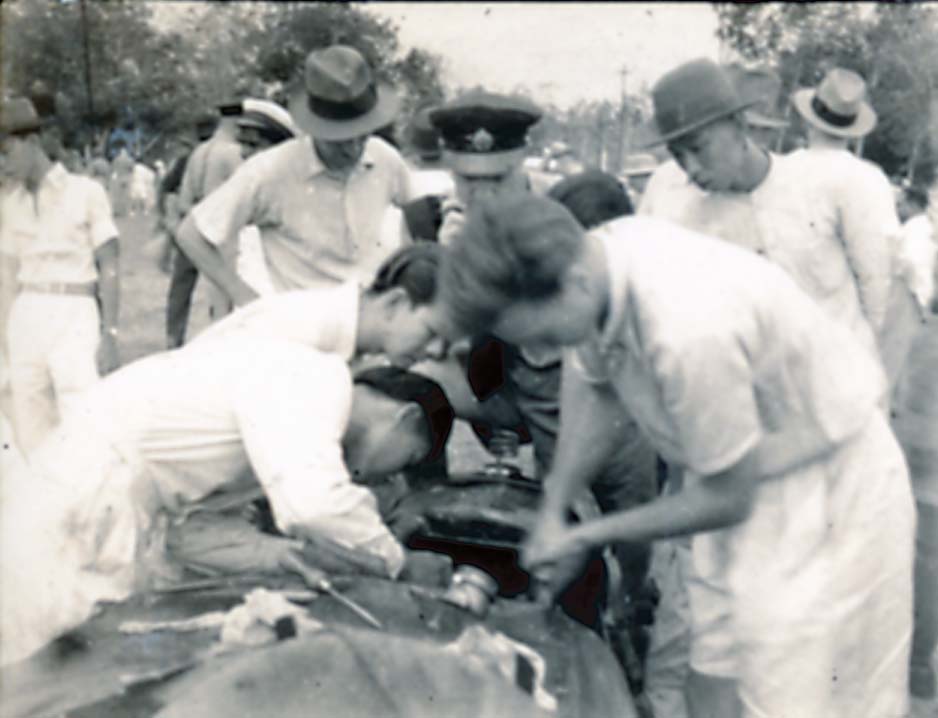
Chia Eng Quee and Ah Soon, together with Anthony Dockray Phillips, attempting to clear the carb jet of the No.15 LA Special.

The Alpha & Omega Special in Johore.
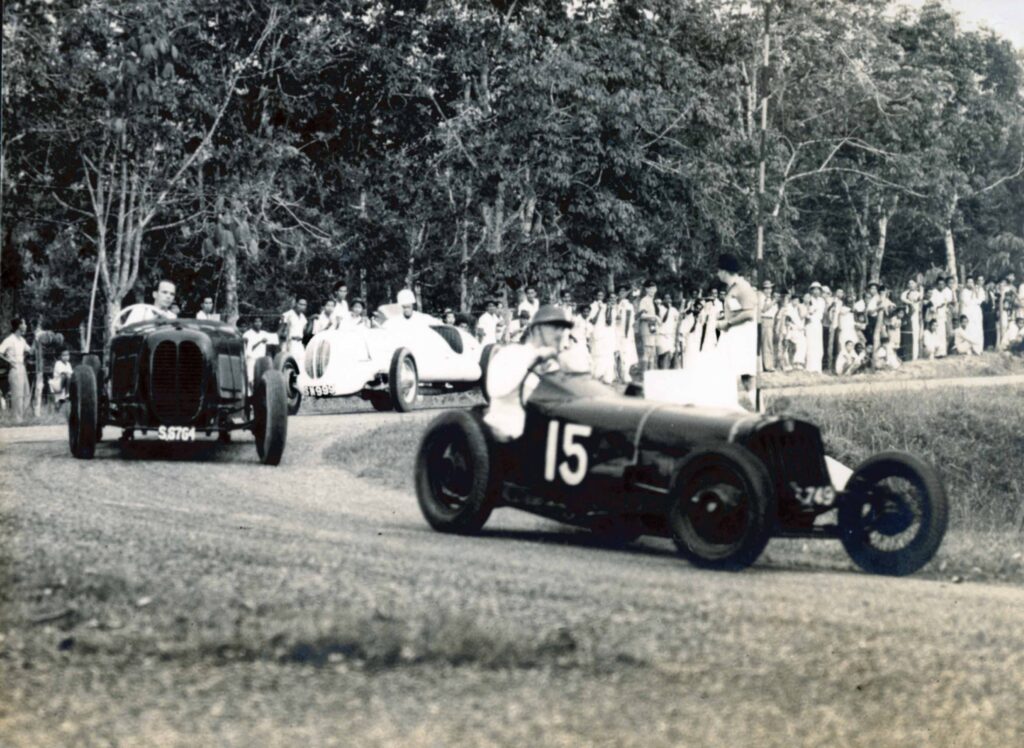
Anthony Dockray Phillips in his LA Special, 3622cc Ford V8, twin carbs – from L.A. No.1! The chassis was from a modified Fiat Ballila. The car had a solid axle, which compromised handling round Johore Turn. Behind the LA is Jimmy Milne is his V8 LA Special, and behind Milne is the LA. Ghost.
At the end of the day, the fastest individual laps were as follows:
Lim Peng Han – 1m 59 4/5s – L.A. Special Ford V8
Lim Kok Tai – 2m 5 4/5s – MG TB
R.D. Bell – 2m 7s – Alvis Speed 20
A.D. Phillips – 2m 7 1/5s – L.A. Special Number 2 Fiat-Ford V8
C.O. Jennings – 2m 9 1/5s – MG K3 Supercharged
Conrad Oldham – 2m 10s – L.A. Ghost Ford V8
P.K. Braid – 2m 11 4/5s – Braid Special Fiat Straight-Six
J.A. Milne – 2m 15 1/5s – L.A. Special Number 1 Ford V8
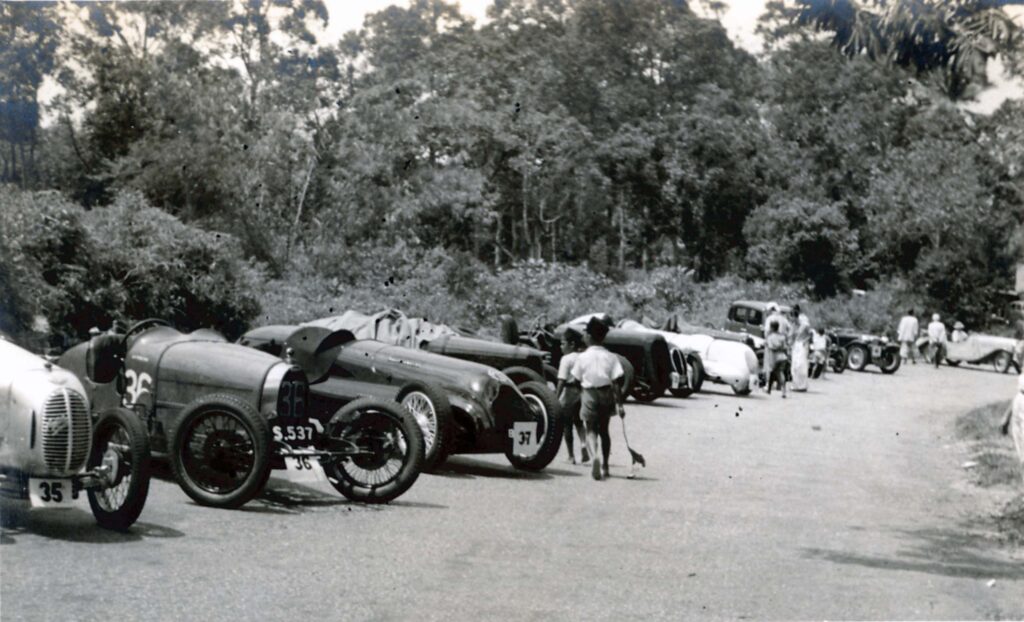
Gap Hill Climb 1940 – Austin (Geoffrey Richard Gwynydd Maund), Bugatti Type 37 (Lim Peng Han), K3 (Mick Jennings), LA Special (Peter Braid), Chevremban (Neville Reddish), Holloway Special (Ted Holloway), LA Ghost (Conrad Oldham), “Works” LA (Anthony Phillips & Peng Han)…what a selection. Many of these cars were present at the 1940 Johore Grand Prix as well.
A driver had to qualify for one of the semi-finals, failing which, he would be entered in the Losers’ Race. The Grand Prix was for just five cars, and by the time this was run on 24 November, the grid had been whittled down Flight-Lt Tony Phillips in his L.A. Special Ford V8, Fiat Balilla chassis, the L.A. Number 1’s engine shoehorned into the Fiat chassis; Neville George ‘Red’ Reddish, who had joined Borneo Motors in January 1926, in his Austin 7 Special, not the Chevremban “The Battleship” Chevrolet V8; Jimmy A. Milne, then a Service Manager with Universal Cars in Singapore, in his L.A. Special Ford V8 Number 1, the first Special built by Lim Peng Han; Charles Vernon Crowther-Smith in his Fiat Victoria Special 1,090cc; and Lim Kok Tai in his MG TB, road registration SN20. There was confusion with the handicapping system, a concept foreign to the local racing scene but practiced at Brooklands in the 1930s. Favourite, and pacesetter, Lim Peng Han had misjudged this and had been eliminated in the Semis. Jennings’ highly-tuned K3 MG developed engine trouble and ended up out as well, but not before setting the lap record.
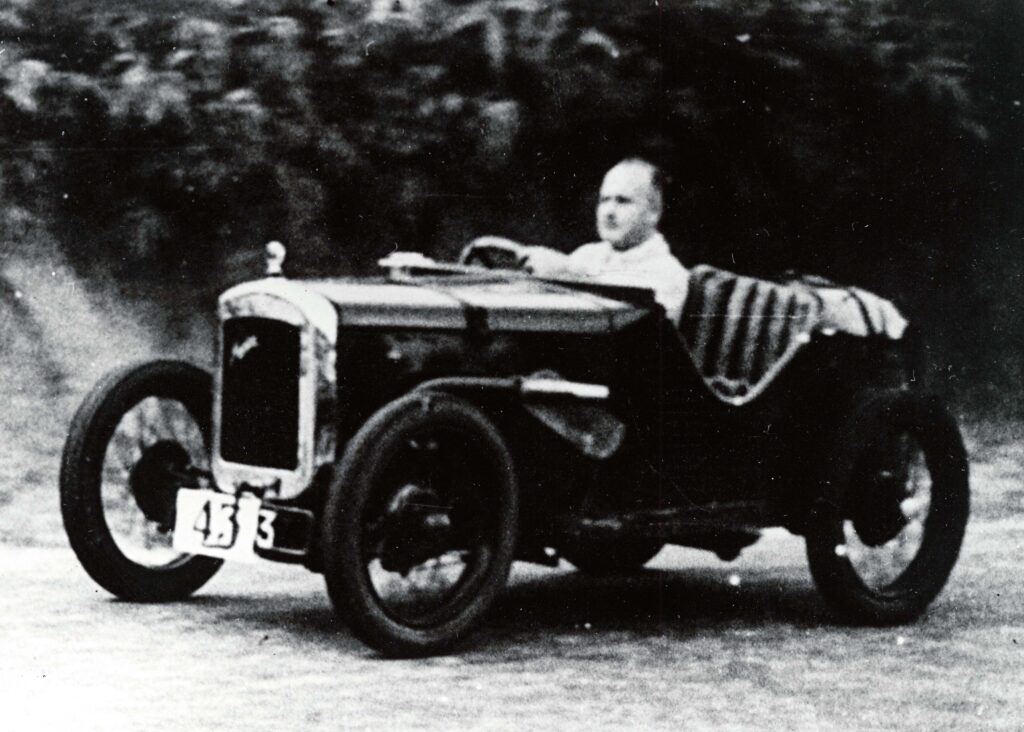
TO QUALIFY FIRST
TO QUALIFY FIRST: The best-laid plans of mice and men often go awry, as it proved during the following Saturday. The roads around the circuit were closed at precisely 3.45pm with Race 1 of four that afternoon was set to commence at 4pm. But the weather threw a spanner in the work. Race 1, a seven-lap race for cars 1100cc capacity and under saw C.V. Crowther-Smith beat ‘Red’ Reddish and Mick Jennings with Geoffrey Maund dropping out. The top three qualified for the semi-finals, set for Sunday.
Results: Race 1
1– C.V. Crowther-Smith – 14m 41 3/5s
2 – N.G. Reddish – 15m 4 3/5s
3 – C.O. Jennings – 15m 56 3/5s
Out – Geoffrey Maund
While a few of the drivers managed practice laps, the weather broke and Race 2 (four cars of 1500cc and under); Race 3 (unlimited capacity cars for just three cars); and Race 4 (unlimited capacity for four cars) were postponed to Sunday. The Northeast Monsoon was playing havoc with schedules, and with the circuit.
Rains forced the organisers to postpone the Grand Prix race a week later to 24 November 1940. Even so, the race was red flagged just over 5 laps after two of the five cars crashed out. Phillips was declared the winner in his 3.6-litre Ford V8 L.A. Special.
Race 2 for four cars of 1500cc capacity and under began at 4pm, with the top three progressing into the semi-finals. The pilots were taking the game to new highs with Arthur Loughborough in his Alpha and Omega L.A Special setting a record lap time of 1m 46 4/5s but it was local boy Lim Kok Tai who finished the race first.
Results: Race 2
1 – Lim Kok Tai – 14m 3/5 sec. Fastest lap 1m 58 1/5s
2 – P.K. Braid – 14m 21s Fastest lap was 2min.
3 – A.J. Loughborough – 14m 28s
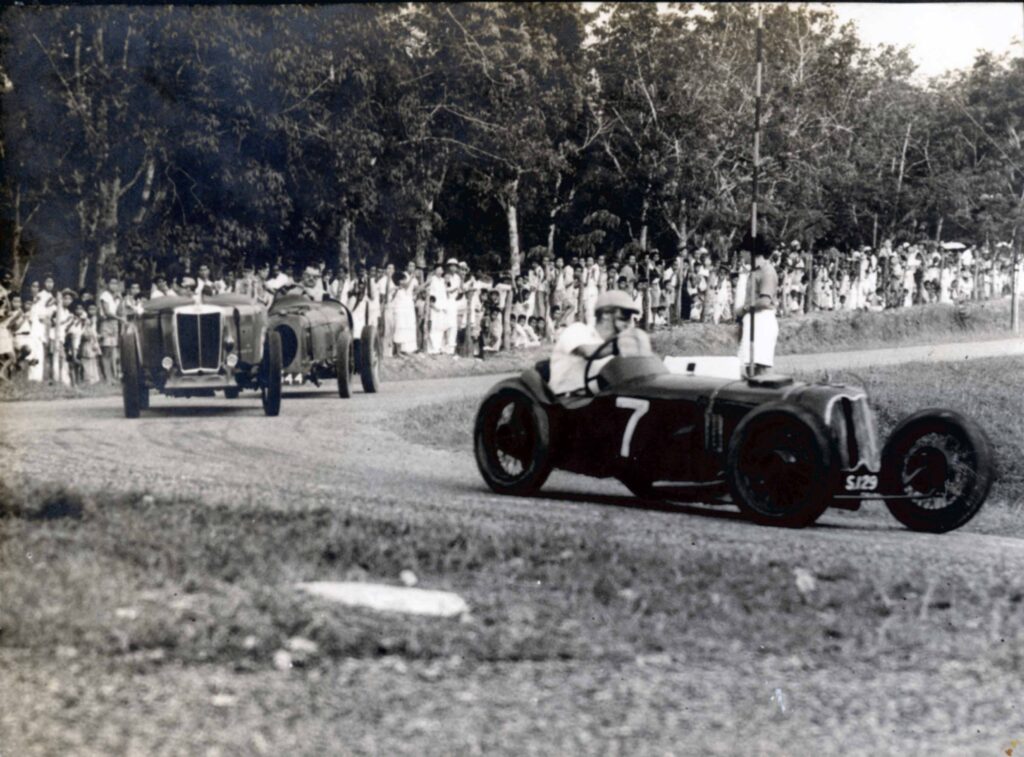
Arthur Loughborough’s six-cylinder Fiat-engined Alpha & Omega L.A-built Special (No.7), seen here ahead of Lim Kok Tai in his MG TB and Captain Peter Braid in his Braid Special, yet another of the Lim Peng Han-built six-cylinder 1493cc Fiat-engined race cars. The trio, all road-registered cars in Singapore, were battling in the 1500cc race on Sunday, 17 November 1940. AJL’s Fiat Special had a straight-six OHV 1493cc Fiat motor. The chassis was built to his design from Wolseley parts, with 1/4 elliptic springs all round. Behind the Apha & Omega Special is Lim Kok Tai in his Blue Flame TB Special. Trailing the TB is Peter Karl Braid in his Singapore registered (S944) Braid Special Fiat Straight-Six OHV 1493cc.
Race 3 was for three unlimited capacity cars over seven laps. The two fastest would progress to the semi-finals and Tony Phillips took the win and set FTD.
Results: Race 3
1 – A.D. Phillips – 14m 8s Fastest lap 1m 50 1/5s
2 – J.A. Milne – 14m 23 1/5s
3 – Conrad Oldham – 14m 25 3/5s
As with Race 3, Race 4 was for unlimited capacity cars, but with four entries, the fastest two going into the semi-finals. Here, Lim Peng Han upstaged British Malayan Broadcasting Company (BMBC) senior studio engineer and producer John Barraclough in his 2½-litre SS100, the Ford V8 and Lim’s experience giving him the edge.
Results: Race 4
1 – Lim Peng Han – 13m 1 3/5s Fastest Lap 1m 47 1/5s
2 – J.F. Barraclough – 13m 34s
3 – N.G. Reddish – 13m 50 3/5s
4 – R.D. Bell – 14m 38 3/5s
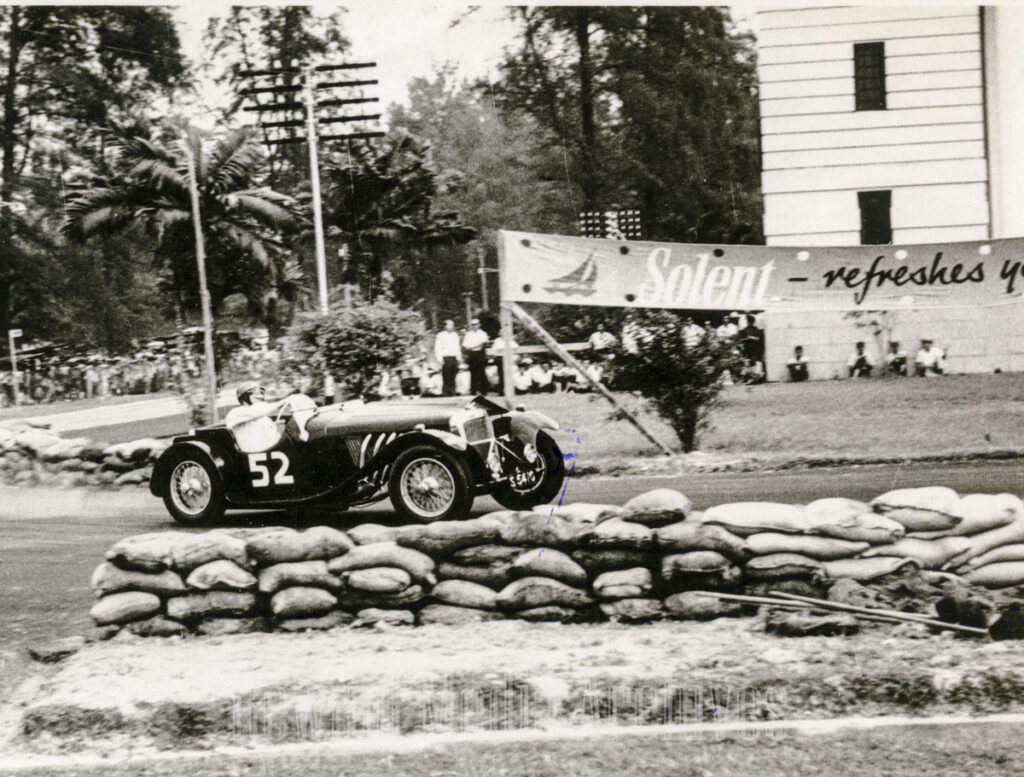
DRAGGING THE RACE
DRAGGING THE RACE: There wasn’t time for Semi-Finals by nightfall and the organisers made the executive decision to carry over the races to the following Sunday, 24 November, wholly intent on completing this exercise. Racers packed up their bags and most drove across the Causeway back. Into Singapore to their daily lives, not knowing which was more disruptive, air raids and black outs or three weeks of motor racing.
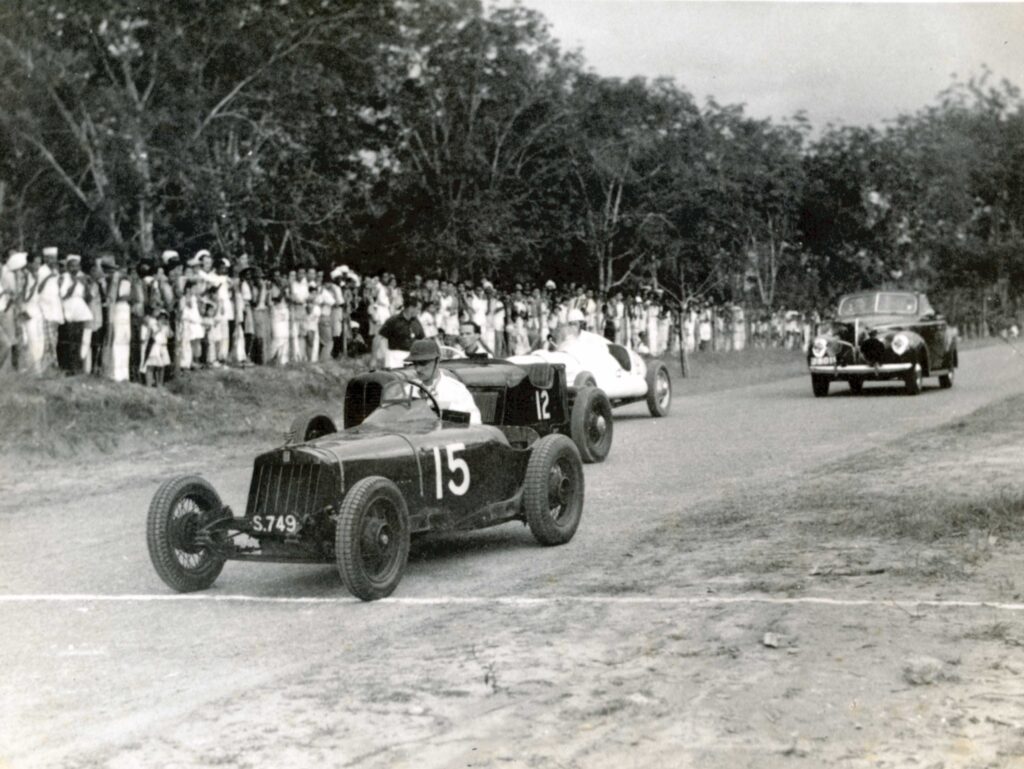
Start of the second Unlimited Scratch race with Anthony Phillips ahead of Jimmy Milne and Conrad Oldham.


Peter Braid approaches the Grand Stand Bend during the Johore Grand Prix.
The following Sunday’s races began in earnest at 2pm with the first Semi-Final, a five-car race with top three qualifying for the Grand Prix. Handicapping placed Lim Peng Han on scratch, hardly a desirable position given that Phillips, who was running a similar V8 engine, had a 57 second handicap. Red Reddish’s 105 second handicap was probably too much for the Austin Seven Special to uphold against Lim, Phillips, Braid and Crowther-Smith but when the chequered flag fell after seven laps, it was Perak-based Crowther-Smith in first, Phillips in second, Reddish in third, Lim in fourth and Braid in fifth. Crowther-Smith, Phillips and Reddish qualified for the Grand Prix.
Finishing Order 7 laps with actual overall time and handicap
1 – C.V. Crowther-Smith 14m 31s (86s handicap)
2 – A.D. Phillips 14m 13s (57s handicap)
3 – N.G. Reddish 15m 4s (105s handicap)
4 – Lim Peng Han 13m 53s (scratch)
5 – P.K. Braid 15m 22s (68s handicap)
The second Semi-Finals was for also for five cars, with the first three qualifying for the Grand Prix. John Barraclough was on scratch in his SS100 and Lim Kok Tai had a 27s handicap in his MG TB, a superlative performance against cars of much higher capacity. Milne had a 42s handicap, Arthur Loughborough had an amazing 46s handicap, due in part to electrical gremlins, and Mick Jennings’ was 123s, which, had his K3 not been acting up, would have been the best sandbagging exercise for such a handicap event. Alas, Jennings did not complete the race and Barraclough crashed the SS100. This left Milne to win ahead of Lim Kok Tai and Loughborough.
Finishing Order 7 laps with actual overall time.
1 – J.A. Milne 14m 44s (42s handicap)
2 – Lim Kok Tai 15m 44s (27s handicap)
3 – A.J. Loughborough 15m 39s (46s handicap)
C.O. Jennings – DNF; Barraclough – crashed
Next up was the Losers’ Race – for cars not in the Semi-Finals. Reddish was on scratch in his second car, the Chevremban. The Judge’s Ghost was on 30s, Bell, the event’s medical doctor, was on 41s and Maund brought up the rear in his Austin Seven with a 135s handicap. But that was not the end of it. Reddish didn’t start the race, nor did Bell’s Alvis Speed 20. This left Oldham and Maund to potter around the course – which is how the race finished.
Finishing Order
1 – Conrad Oldham
2 – Geoffrey Maund
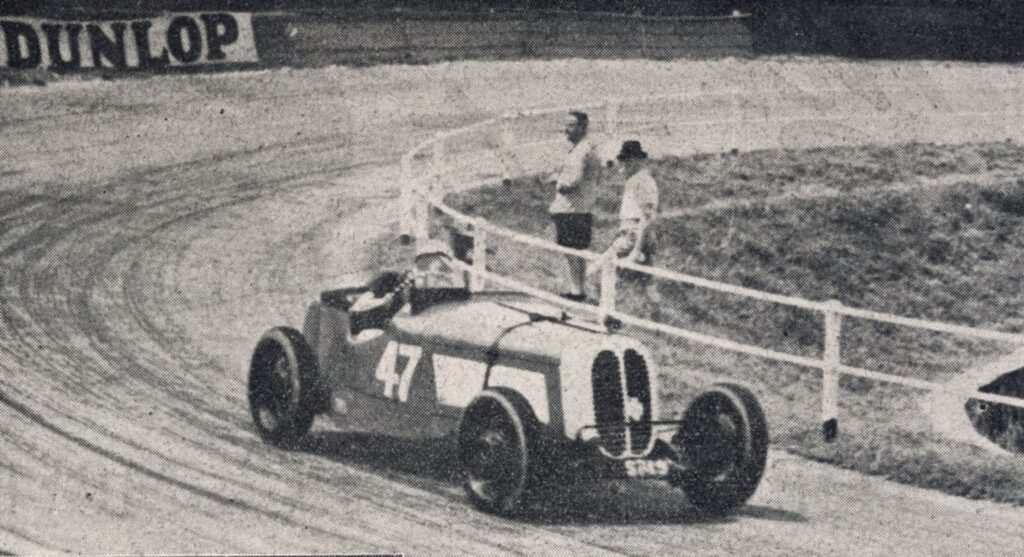
THE LONGSET GRAND PRIX
THE LONGEST GRAND PRIX: Much thought must have gone into the re-organisation of the races as the organisers were forced to postpone the Grand Prix after rain had caused the races to be abandoned on the 17th. The first race on Sunday, 24 November, was meant to be the Losers’ Race, and this had been intended to be held in the mid-afternoon around 3pm as a handicap event open to any of the cars that had not finished in the top three places of the previous scratch races. This would be an opportunity for the winner to qualify for the Semi-Finals, but this was not to be as a Malaya war-preparation black-out at night came into force, necessitating all the races to be brought forward so that the Grand Prix could be held at 2pm and end at between 4.00pm and 4.30pm. If all went to plan, Johore’s Tunku Mahkota would be able to present the prizes before sundown. If all went according to plan.
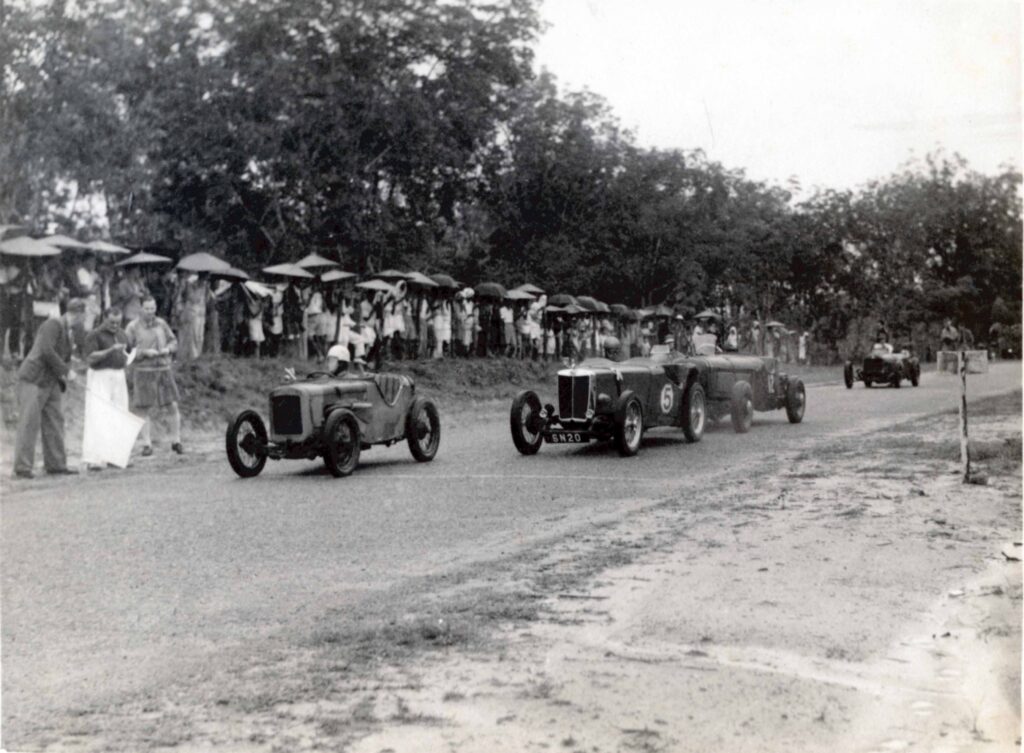
Start of the 1940 Johore Grand Prix. Dato’ Arthur Leonard Birch (Chief Electrical Engineer, Johore – in white trousers) officiates at the start. Drivers/Cars: Neville Reddish, Austin 7 Ulster TT 747cc (Supercharged)(1); Lim Kok Tai, Blue Flash MG TB (5); Jimmy Milne, LA Special Ford V8 3622cc (12); Charles Vernon Crowther-Smith,. Fiat Special (3); Anthony Dockray Phillips, L.A. Special Ford V8 3622cc (15)
With all the confusion surrounding handicapping, 24-year-old Flight-Lt. Arthur Loughborough’s must have wondered what he did right, the electrical gremlins that caused his No.7 Alpha & Omega Special (road registered S129) contrived to be a blessing. Or perhaps it was a cunning manoeuvre because his handicap gave his a suitably good edge to make it into the finals, at the expense of Lim Peng Han, whose car was one of the fastest cars on the circuit.
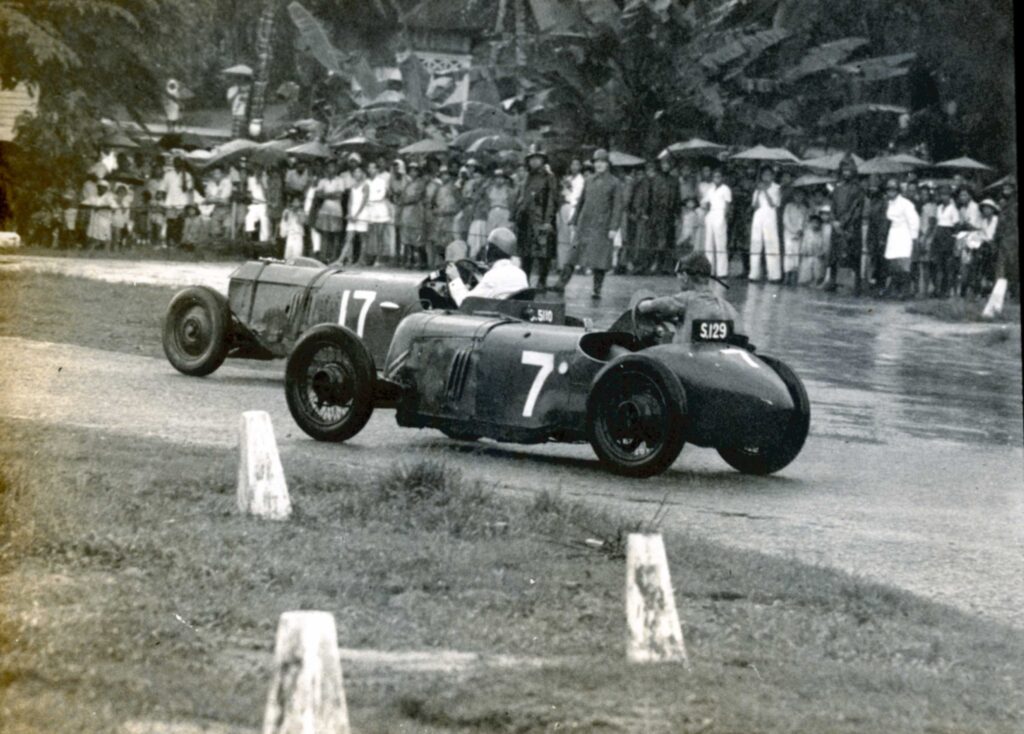
Another Lim Peng Han Special – Arthur Loughborough’s the Alpha & Omega Special had a six-cylinder overhead valve Fiat motor of 1493cc. Lim would have retained the independent front suspension set up off the original donor car, as well as the four speed gearbox which had synchros on first and second ratios, far advanced for its time. Here the Alpha & Omega (#7) battles it out with Lim Peng Han’s L.A. (#17) Special in the wet. Pancheri Collection
If handicapping was a concern, it couldn’t compare to the treacherously slippery course, the rains having made it “practically impassable”. The race was just 10 laps with just five cars running to handicap rules once more, rather than a scratch race. Tony Phillips was on scratch, Crowther-Smith had a 15s handicap, Milne was on 21s, Lim Kok Tai was on 22 and Reddish’s little Austin Seven Special was on 33s.
When Crowther-Smith crashed opposite the grandstand and Lim Kok Tai and his MG TB landed square on top of the Fiat after just 5½ laps, it was too much for the organisers to digest and the race was “red-flagged” with just three cars left running. Jimmy Milne saw the lighter side of things when he described the crash scene as “pornautographic”.
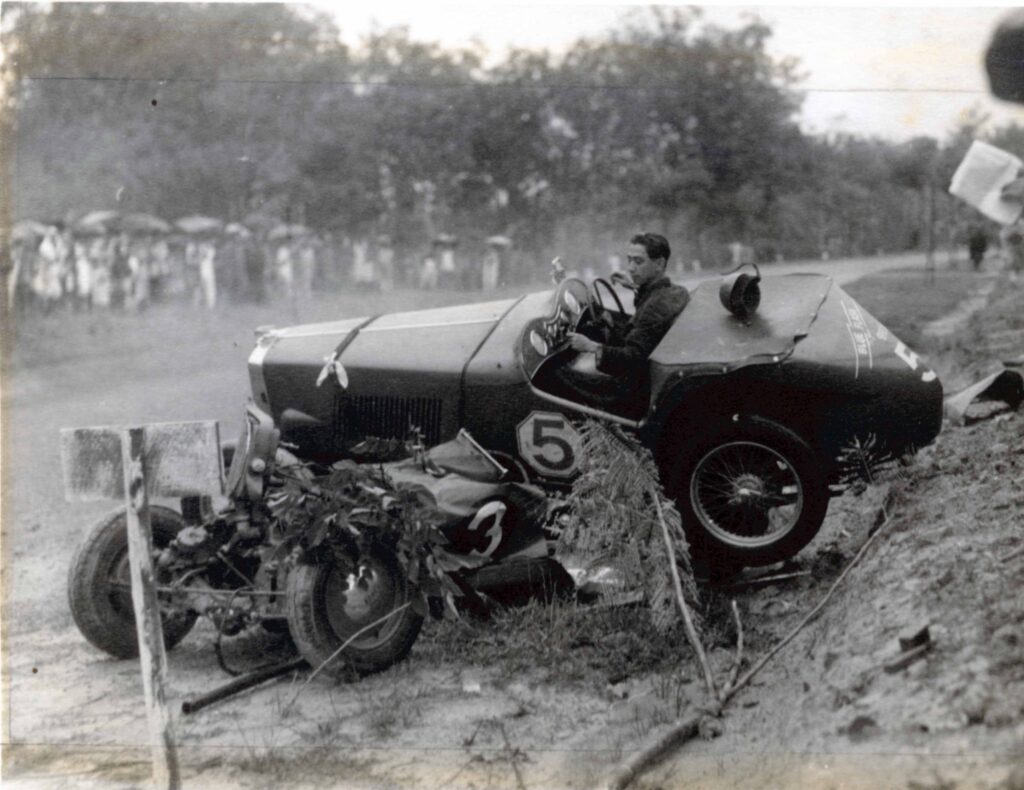
Lim Kok Tai’s Blue Flash Special (essentially a TB with a boat tail), road registration SN20, sits atop Charles Vernon Crowther-Smith’s Fiat Special. The original caption read: “Capt. Bell RAMC was attending to Crowther-Smith behind the post in the left of the picture when the second crash happened. He didn’t appear to notice anything and looked most surprised to see two crashed cars when he looked up!!”
When the red flag came out, Fl.-Lt. Anthony Phillips was in front and was thus awarded the Grand Prix win in his 635kg (1,400 lb) L.A. Special. Second place went to Austin enthusiast and Borneo Motors manager ‘Red’ Reddish in his supercharged 747cc Austin 7 Special. Singapore-entrant Jimmy Milne, a proponent of the locally built special, was third in his L.A. Special Number 1, Lim Peng Han’s first 3622cc Ford V8-powered L.A. Special. The three survivors were flagged down and “toured to the finish”. The confusion over handicapping had put a cat amongst the pigeons and not everyone was able to come to grips with it, an anti-climax to an otherwise entertaining three weeks of motor racing in Johore. Crowther-Smith’s wrecked Fiat; John F. Barraclough’s overturned Jaguar SS100 (driver and car were unhurt); and Lim Kok Tai’s damaged MG TB were towed away so that the roads could be reopened to the public.
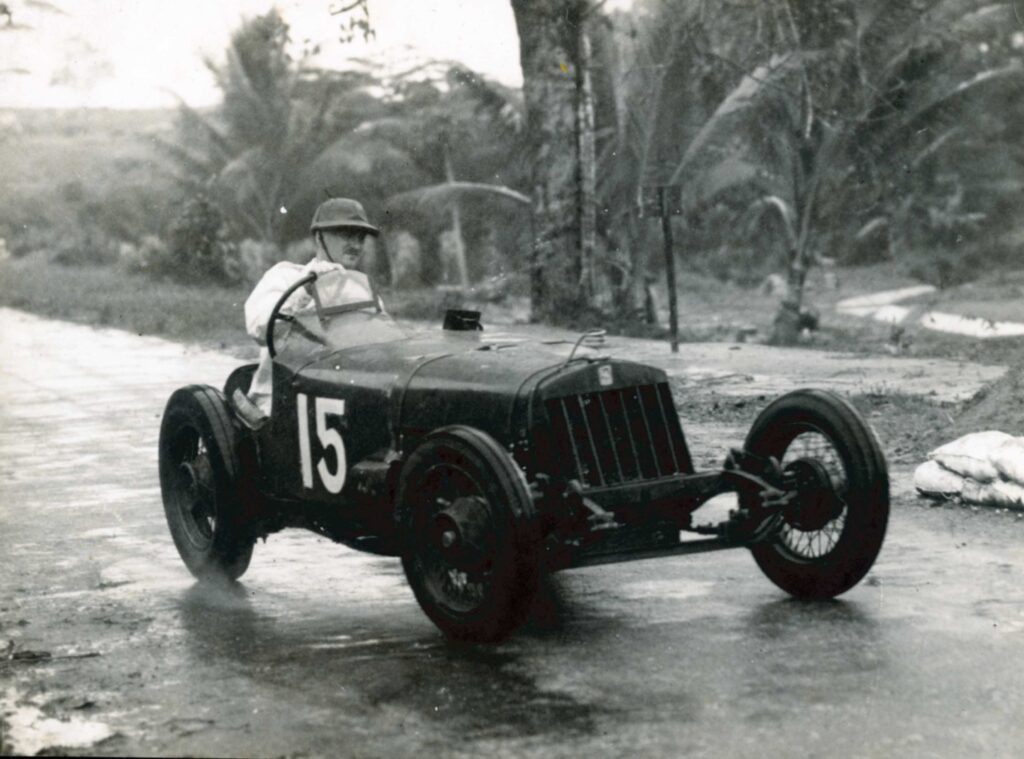
Anthony Dockray Phillips approaches the last corner in the Johore Grand Prix. This was the L.A.’s last victory. The astute read will notice that the registration plate has either fallen off, or been removed.
“The Johore Grand Prix,” wrote Tony Phillips, “was the result of a very determined effort by PKB [27-year-old Peter Braid] to get a proper road race. It was a pity that he was the only one of the organisers to have any idea of the business so that when the meeting finally came off it was not very satisfactory for either drivers or spectators. One spectator remarked that the show only lacked the Marx Brothers to make it complete. However no one was killed and the balance sheet had a substantial profit, so had there been a next time, no doubt the whole thing would have been done better.”
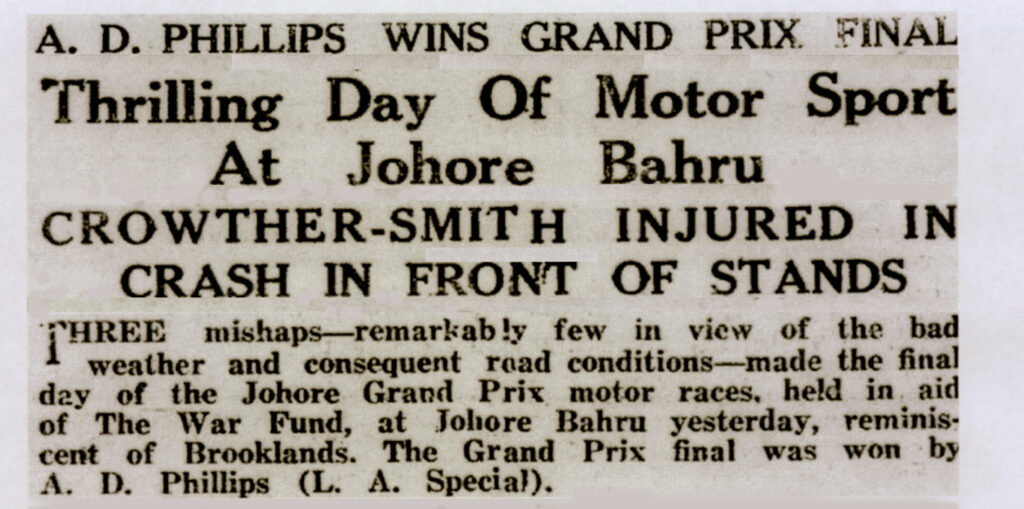
Final Results after 5½ laps – no times, race red-flagged
1 – Fl.-Lt. Anthony Dockray Phillips
2 – Neville George ‘Red’ Reddish
3 – Jimmy A. Milne
Lim Kok Tai (Crashed)
C.V. Crowther-Smith (Crashed)
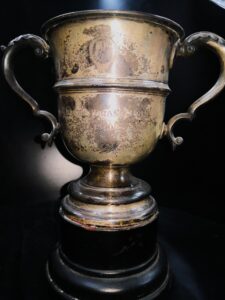
POSTSCRIPT
POSTSCRIPT: This as the cliché goes, was the Genesis of grand prix motor racing in Asia. Captain Peter Braid, who was really the brains behind the Grand Prix, and Jimmy Milne advertised their cars for sale shortly after the race. The L.A. Special No.1 that Jimmy Milne had raced to third place was also offered for sale at Lim Peng Han’s Lim Motor Garage on the same date the Braid advertisement appeared in the newspapers. The winds of war were blowing stronger and stronger, Volunteers Services commitments and redeployments meant that a number of those active in the Malayan Automobile Association’s Sporting Committee were unable to devote time to such pleasures. Many of the cars entered in the Grand Prix later perished and those that survived owe much to the resourcefulness of Lim Peng Han and the early post war generation of enthusiasts.
FULL ENTRIES – race numbers indicated
1 – Geoffrey Richard Gwynydd Maund – Austin 7 747cc
2 – Neville George ‘Red’ Reddish – Austin 7 Ulster TT 747cc (Supercharged)
3 – Charles Vernon Crowther-Smith – Fiat Special 1090cc [or was it a Fiat 1496cc engine?]
4 – Capt. Cyril Oswald ‘Mick’ Jennings R.E. – M.G. K3 Magnette Straight-Six OHC 1086cc (Supercharged)
5 – Lim Kok Tai – MG TB 1292cc (sic)
6 – Richard Aubrey Witham – Bitzer Special 1490cc [Scratched]
[It is not known why Witham scratched. The car was offered for sale just prior to the Grand Prix. Richard Aubrey Witham [b.1904 d. 14.11 1946] was a planter in Malaya, Ulu Remis Estate Oil Palm; Layang Layang, Johore; Bukit Rajah Rubber, Klang. Lt. 2FMSVF POW Singapore to Thailand. Died in Amsterdam air disaster 14.11.1946. The Times, Wednesday, Nov 20, 1946; pg. 1; Issue 50613; reported that Witham died Nov 14, 1946 in the air disaster at Amsterdam. Last know address of Capt. Richard Aubrey Witham, F.M.S.V.F., was Widford Lodge, Chelmsford [formerly of Bukit Rajah, Klang, Malaysia].
7 – Fl.-Lt. Arthur James Loughborough – Alpha & Omega Fiat Special Straight-Six OHV 1493cc
8 – Capt. Peter Karl Braid – Braid Special Fiat Straight-Six OHV 1493cc
9 – Lt. David Charles William Nunneley – SS Jaguar Tourer 2663cc
10 – Capt. R.D. Bell R.A.M.C. – Alvis Speed 20 Straight-Six OHV 2762cc
11 – John Francis Barraclough – SS100 Jaguar 2½-litre 2663cc
12 – Jimmy A. Milne – L.A. Special Number 1 Ford V8 3622cc
13 – No entry
14 – Neville George ‘Red’ Reddish – Chevremban Straight-Six OHV 3548cc
15 – Fl.-Lt. Anthony Dockray Phillips – L.A. Special Ford V8 3622cc
16 – Conrad Oldham – L.A. Ghost Ford V8 3622cc
17 – Lim Peng Han – L.A. Special Number 2 Ford V8 3622cc
DNA – Nai Charoon na Bangchang – Alfa Romeo 6C 1750

